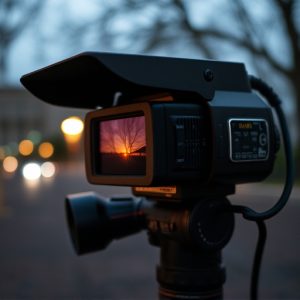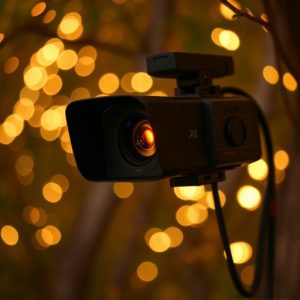Protect Your Home: Counter Surveillance Guide to Disguised Cameras
In today's digital era, disguised cameras for home protection have become crucial for safeguard…….
In today's digital era, disguised cameras for home protection have become crucial for safeguarding privacy and security. Security professionals employ advanced techniques and equipment to detect and neutralize hidden threats, ensuring the safety of homes, businesses, and critical infrastructure from unwanted surveillance. Counter surveillance sweeps identify and mitigate hidden monitoring devices like miniature cameras, wireless CCTV systems, motion-activated outdoor cameras, and audio-visual bug detectors, providing peace of mind and protecting sensitive information from prying eyes.
In today’s digital age, the threat of disguised cameras poses a significant risk to privacy. This comprehensive guide delves into counter surveillance sweeps, empowering individuals with professional methods to safeguard their homes against hidden threats. We explore the basics of counter surveillance, dissecting common types of hidden cameras and their uses. Leveraging advanced technology like thermal imaging and RF detection, we provide detailed techniques for identifying and neutralizing these devices. Additionally, we offer best practices for home protection, legal insights, and tips to stay ahead of evolving technologies, ensuring peace of mind in the face of this modern-day enigma.
- Understanding Counter Surveillance: The Basics
- – Definition and importance of counter surveillance sweeps
- – Common types of hidden cameras and their uses
Understanding Counter Surveillance: The Basics
In today’s digital age, understanding counter surveillance is paramount for both professionals and individuals seeking to protect their privacy. Disguised cameras for home protection have become a common tool in this landscape. These sophisticated devices are designed to remain hidden, making them highly effective at deterring potential intruders while offering peace of mind. From motion-activated cameras disguised as rock formations or garden gnomes to wireless options that blend seamlessly into everyday decor, the market offers diverse solutions tailored for various needs and budgets.
Professionals in security and surveillance employ advanced techniques to identify and neutralize these hidden threats. This involves meticulous inspections, utilizing specialized equipment to detect even the most subtle camera placements, and implementing strategies to disrupt or remove them. By staying ahead of evolving technology used in counter surveillance, experts ensure that homes, businesses, and critical infrastructure remain secure, safeguarding against unwanted prying eyes.
– Definition and importance of counter surveillance sweeps
Counter surveillance sweeps are essential operations designed to identify and neutralize hidden monitoring devices, such as disguised cameras for home protection, that could compromise individual privacy and security. In today’s digital age, where technology facilitates sophisticated surveillance methods, professionals must employ meticulous techniques to detect and mitigate these threats. These sweeps involve a comprehensive approach, including physical inspections, advanced technology tools, and expert knowledge to uncover hidden or concealed recording devices.
The significance of counter surveillance sweeps lies in their ability to protect individuals, businesses, and critical infrastructure from covert monitoring. Disguised cameras for home protection, while seemingly harmless, can pose significant risks to privacy. Professionals conducting these sweeps must be adept at recognizing various surveillance setups, from simple hidden cameras to more complex systems. By implementing regular counter surveillance measures, one can ensure a safer environment, fostering peace of mind and safeguarding sensitive information from prying eyes.
– Common types of hidden cameras and their uses
Hidden cameras, also known as disguised cameras or surveillance cameras with covert capabilities, are a common tool used for various purposes, from home protection to professional monitoring. These devices come in many forms and can be easily integrated into everyday objects, making them an effective means of surveillance. Some of the most prevalent types include:
1. Miniature Cameras: These are tiny, often no bigger than a button or a coin, making them ideal for discreet placement. They are commonly used in homes to monitor entry points, basements, or any area where potential security breaches might occur.
2. Wireless CCTV Systems: Disguised as regular home decor items like picture frames, plant pots, or even smoke detectors, these cameras transmit video signals wirelessly to a central monitoring system. This makes them convenient for temporary setups or areas with limited wiring access.
3. Motion-Activated Cameras: Designed to capture footage only when motion is detected, these hidden cameras are energy-efficient and can be set up outdoors to monitor gardens, driveways, or perimeter fences, providing advanced warning of potential intruders.
4. Audio-Visual Bug Detectors: Some surveillance equipment combines audio and video capabilities, allowing for both visual and auditory monitoring. These devices can mimic everyday objects like clocks or light switches while recording conversations and activities.
In today’s digital age, understanding and implementing effective counter surveillance methods is crucial for safeguarding your personal space. By familiarizing yourself with various hidden camera types and techniques, you can create a secure environment at home. Remember, proactive measures like regular sweeps and the use of disguised cameras for home protection are essential tools in navigating the challenges of modern privacy concerns. Stay vigilant and take control of your security.


